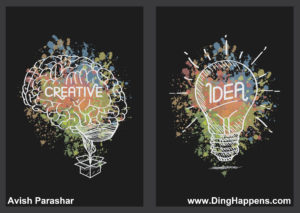Creativity and Innovation
Creativity and innovation are critical business skills in today’s workplace. Most businesses would agree they want their people to be more creative and more innovative. The problem in getting there is two-fold:
- Creativity and innovation are often frowned upon – even though managers say they want their people to be more creative and innovative. Generally, when an employee is being creative or innovative, they’re doing things in a new way. They’re doing things differently than their manager told them to or expected them to. And for many managers this creates a sense of uncertainty and change, which makes them uncomfortable. As a result, they end up stamping out the creativity and innovation as opposed to supporting it.
- Many professionals don’t even realize exactly what it means to be creative or innovative, and if they do, they’re not sure how to do it.
Creativity and Innovation Definition
Let’s look at the definitions of innovation and creativity. They are very similar, but there’s a difference between creativity and innovation.
Creativity is the ability to generate new ideas. Innovation is the act of applying those ideas in a meaningful way.
So in the simplest terms, innovation is applied creativity.
Creativity and Innovation in the Workplace
 In today’s workplace environment, creativity and innovation are more important than ever. The world is changing rapidly. We need to do things differently than we did years ago – even months ago. If we don’t continually innovate, someone else will come along, innovate around us, and we’ll be left behind.
In today’s workplace environment, creativity and innovation are more important than ever. The world is changing rapidly. We need to do things differently than we did years ago – even months ago. If we don’t continually innovate, someone else will come along, innovate around us, and we’ll be left behind.
Similarly, competitors arise in new ways we weren’t expecting. In the past you could see your competition coming because things would take time to develop. You could anticipate new trends in your industry and competition. Now, however, the world changes so fast that a new competitor can put up a website, launch a campaign, and suddenly grab a huge chunk of market share before you even know what hit you. Your ability to be creative and innovate on the fly is going to impact how quickly you can respond to that competition.
Finally, if you want to grow your market share, if you want to lead and leap ahead of the competition, incremental improvement and change isn’t going to cut it. The only way to leap ahead of someone is to start doing things differently. Basically, if you keep doing things the way you’ve always done them, you’ll keep getting the same results you’ve always gotten. If you’ve always been following the market leader, you’ll have to do things differently if you want to become the market leader.
How Do You Foster a Culture of Creativity and Innovation?
There are multiple steps to fostering a culture of creativity and innovation.
As we said before, while companies say they want creativity, not only don’t they reward it, they penalize it! Take a look at your company, your organization, and the culture you’re creating. Are you rewarding people for thinking outside the box and trying new things in new ways?
Similarly, we need a culture where failure is okay. Innovation and new ideas rarely work perfectly the first time – in fact, they often don’t work at all. However, if we punish people for failure they will freeze up. They won’t want to try anything new, and, as a result they won’t try to be creative or innovative. It will be much safer for them to keep doing things the same old way. Check how are you responding when people make mistakes.
Finally, you need to make sure that your people understand how to access their creativity and innovation skills. All people are born creative, but by the time they reach adulthood, most people have had that creativity beaten out of them. We simply are raised not to be creative, but rather to conform, to color within the lines. People will benefit greatly from being trained in how to be more creative, how to tap into the creativity they have, and how to apply it towards innovation.
(Note: one of my favorite examples of a culture of creativity and innovation is Pixar. We can learn a lot from their example…)
Innovation Whitepaper
For more information on Innovation, check out my whitepaper, “Leading Innovation.”
There’s no opt-in or fee. Just click and read. Feel free to share with your group or management team.
How Improv, Ding Happens, and Avish can Help
Avish has a process that uses improv comedy tools, ideas, and principles to help people accept, manage, and take advantage of change. His interactive programs are fun, engaging, and highly relevant.
Avish can help you increase the adaptability in your workplace in several ways:
Speaking at Your Annual Meetings
Presenting ideas around improv and change to a large group of people in a short period of time (45-90 minutes). Avish’s presentations are fun, engaging, interactive, motivational, and designed to open-minds and get people started down the path of adaptability and innovation.
Training at your Workplace
Working hands-on with a smaller group of people for a longer time where the focus is on skills-transfer. Giving your team the skills and practice to implement these ideas in the real word.
Facilitation at Your Next Leadership Retreat
Taking your leadership team through a process that helps them create a plan of their own to increase creativity and innovation throughout the entire organization.
Get Started!
Contact us now to book Avish to help your team respond to, embrace, and take advantage of change in the workplace!
Or, use one of the following links to get more information:





